Deep down, though I don’t indulge in it too often, I have a penchant for bling. I like sparklies and I like beads and I like shiny stuff.
This doesn’t come across too often in my embroidery. It doesn’t even come across in my household decor or my clothing. And I rarely wear jewelry. But for some reason, when I see beads, sparkles, texture, shine – within reason – I am attracted to it. I like to look at it, examine it, entertain ideas about what to do with it.
And while I’m not really into formal bead embroidery, I like playing with beads and embroidery stitches. Lately, I’ve been doing just that.
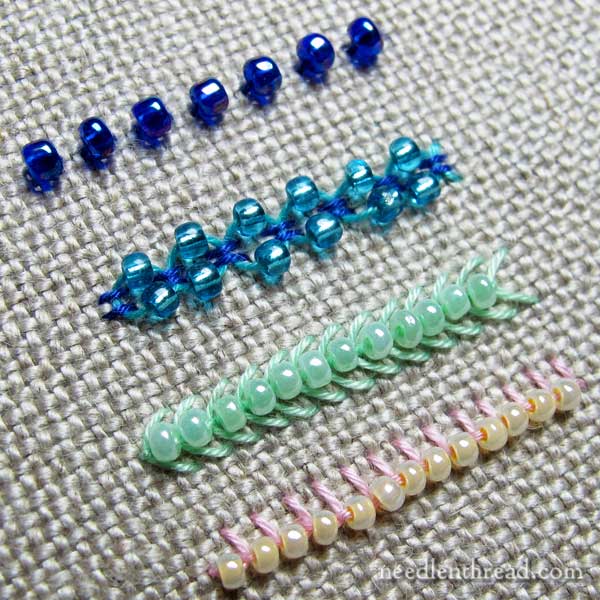
While mucking about with beads and stitches, I’ve discovered that it’s easy to add beads to just about any embroidery stitch. From simple to complex stitches, there’s always room for a bead!
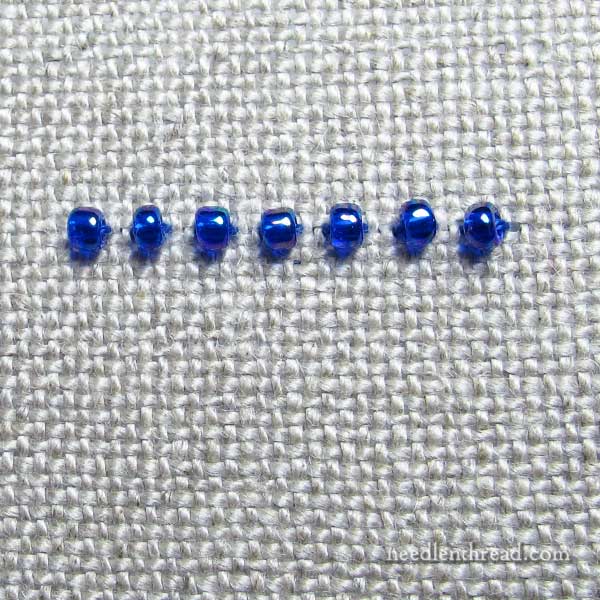
Take, for example, the very basic running stitch. What could be more natural than using it to anchor regularly spaced beads to a piece of fabric?
There’s no trick to it – bring the need and thread to the front of the fabric, load a bead, take the needle and thread to the back of the fabric. Repeat.
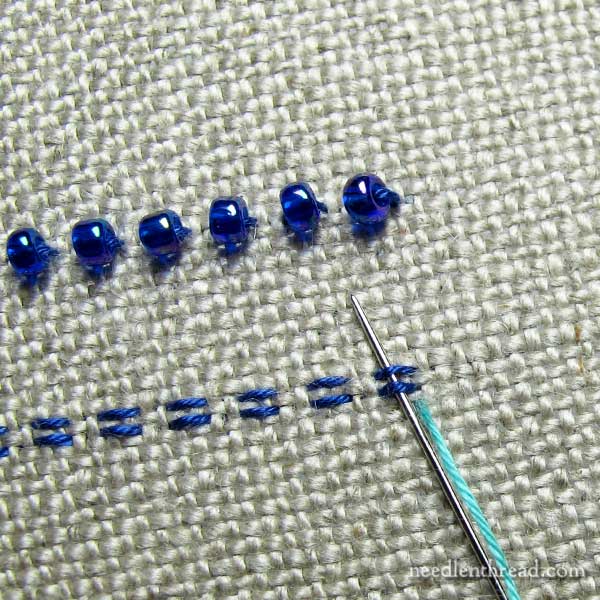
You can bead up the running stitch in different ways, too. For example, laced running stitches, whipped running stitches – they can involve beads, too.
I’ve worked two parallel rows of running stitch, and now I’m going to lace them, by taking a different thread underneath each set of running stitches, alternating the direction of passing under each set of stitches.
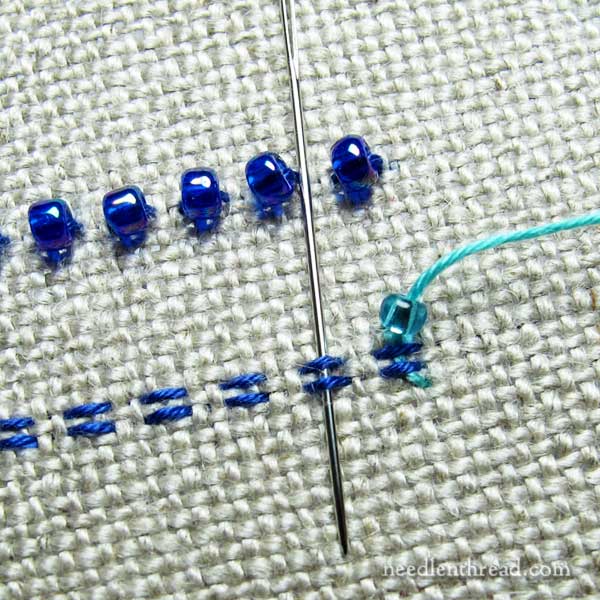
Before I pass the needle underneath the second set of stitches, I loaded up a bead.
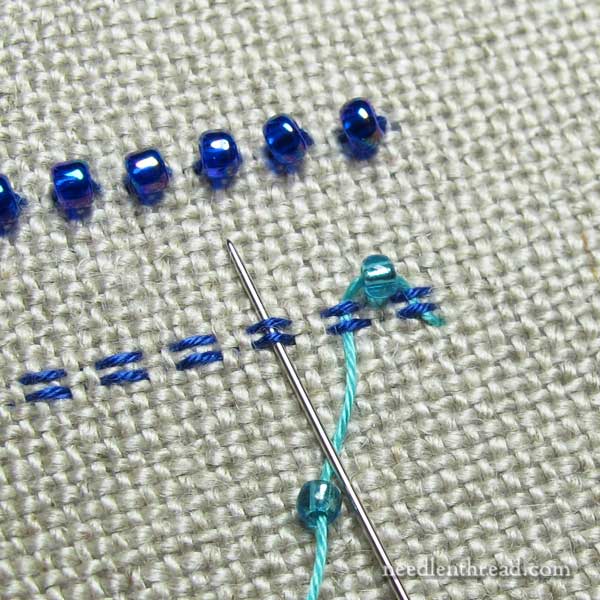
And then I did the same thing before passing under the next set of stitches.
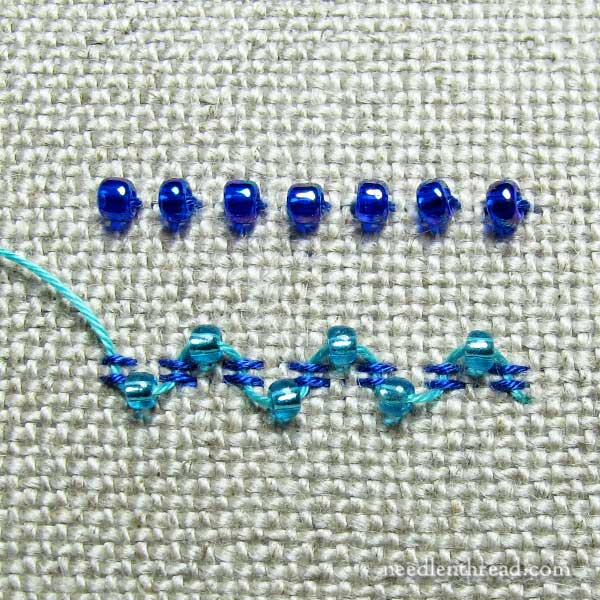
So, so simple!
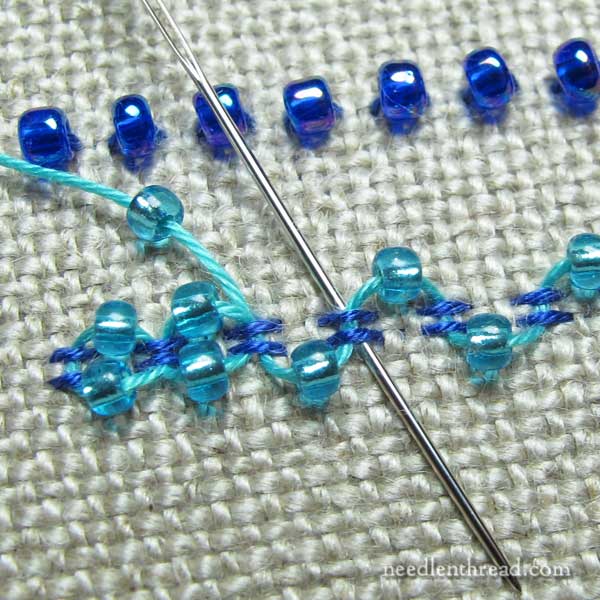
And if you want to, you can even work a return journey.
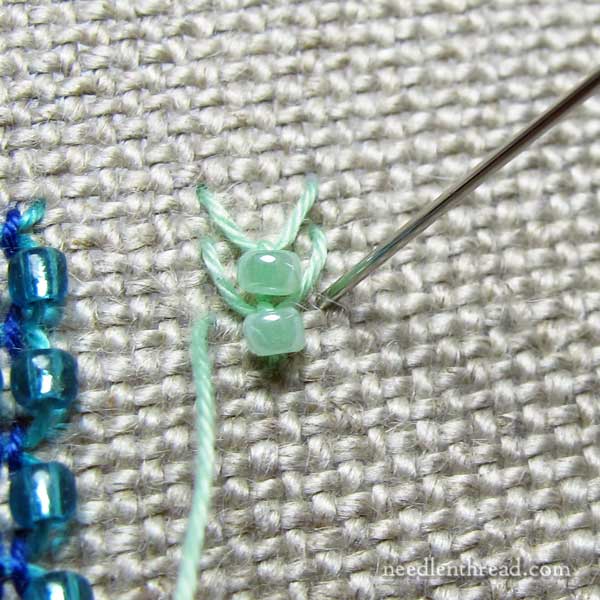
Any type of stitch that involves an anchor stitch – like the fly stitch that’s anchored in the middle, or the detached chain stitch (daisy stitch) that’s anchored over the end of the petal shape – can easily sport a bead. Just load one up on the anchor stitch.
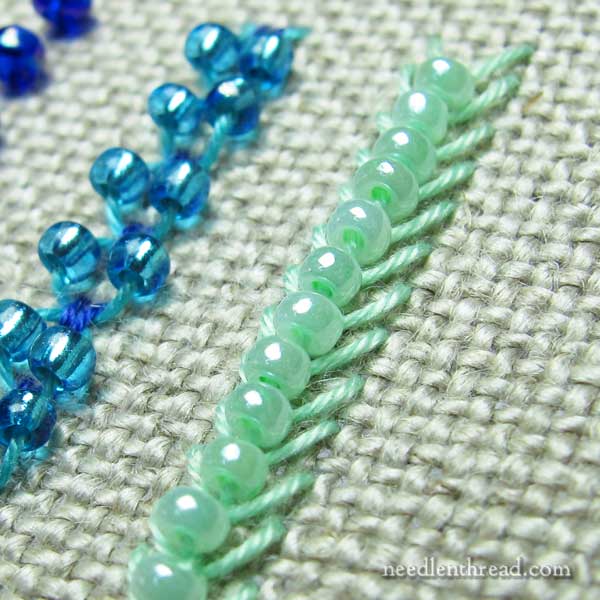
Admittedly, a line of fly stitches with a bead on each anchor stitch might end up looking a bit like a centipede.
But you could easily change the look of that line, simply by changing the spacing on the beads.
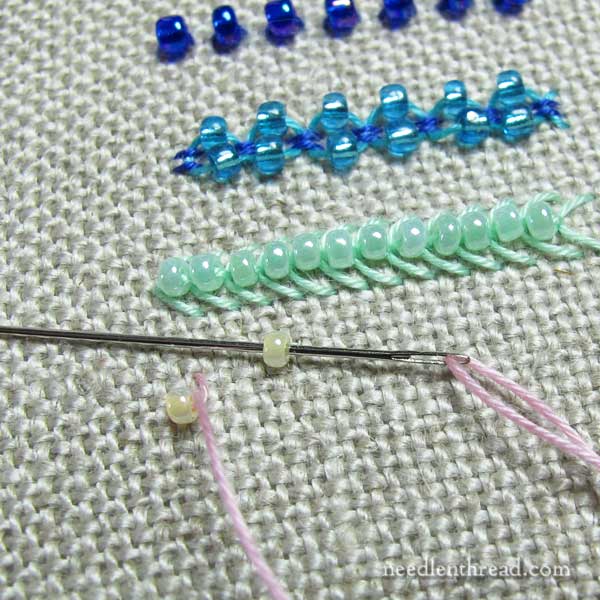
Buttonhole stitch is an easily-beadable stitch, too. Just load up a bead after coming up to catch the previous stitch, before starting the next stitch. Then situate the bead right next to the previous stitch as you bring the needle and thread to the front to catch it in place.
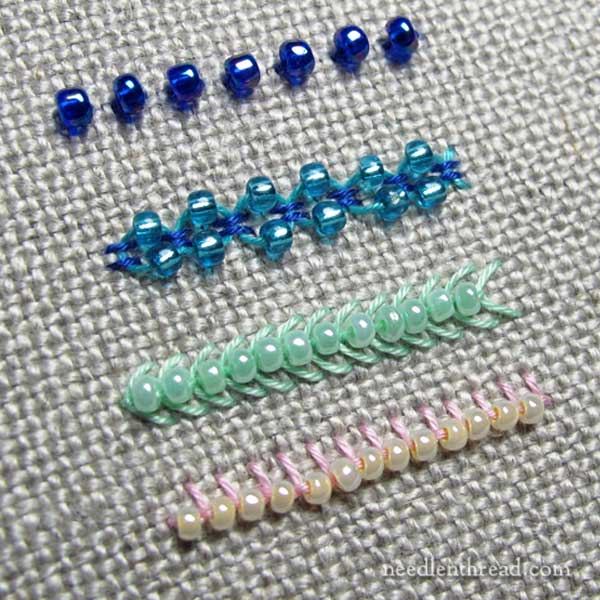
It’s quite fun adding beads to stitches, and if you’re attracted to a bit of bling, too, why not give it a try?
Beads on the Alphabet
If you’ve purchased the Stitch Sampler Alphabet, by the way, there’s no end to where you can add beads on those letters!
Anywhere there’s a French knot, you can add a tiny seed bead. Or you can add beads to any of the anchor or couching stitches on all the different composite stitches. It’s kind of addicting! As long as you don’t go overboard with the beads – judiciously placed, they provide texture, contrast, sparkle and a little life – they dress up the letters quite nicely!
You and Beads?
What’s your take on adding beads to embroidery stitches? Do you like the look? Is it something you’d like to explore? Do you have any favorite stitch-bead combinations? Or any questions about adding beads to stitches? I’ll be visiting the topic again soon, in detail, but in the meantime, feel free to join in the chatter below while we discuss beads and bling in embroidery.
Like what you see?
If you enjoyed this article and you’re looking for more inspiration, information, and instruction on hand embroidery, why not sign up for my daily newsletter?
There are all kinds of reasons to have Needle ’n Thread delivered to your inbox – check them out and sign up today!







Hi Mary.
I’ve done a lot of counter cross stitch, mainly Mirabilia, patterns that involve beading. The way I learned to bead was, using two threads, to bring up the needle at the required spot, load on the bead, and take the needle behind. Then, you come up again in the same place you started the stitch, split the threads around the bead, and take the needs down in the same spot you ended the first stitch. This anchors the bead in place, and is especially useful if you’re not doing a line of beads, for example, but are placing individual beads within an existing, stitched pattern.
What a great technique. Thank you. I have done traditional cross stitch for years but am not familiar with Mirabilia cross stitch. Can you recommend a good web-based or a brick-and-mortar site near Los Angeles, California where it is taught?
Bonnie – Mirabilia is a kit company rather than a technique – if you google them you will see that it is a particular, quite ornate, style, which uses beads. hh
Ah, mystery solved. Thank you for showing how you anchored the beads with the long thread leg sticking out. 🙂 Buttonhole stitch would keep the bead from sliding back and forth.
I do love to add beads to my work. When I’m making a simple design for a birthday card, a bit of metallic filament here and there and a few beads really make the card more festive. I generally do cross stitch so I can also add beads at an angle / / / with a 1/2 cross. That looks wonderful in a tree or flowing gown. Gives it a sense of movement.
I’m a bling girl too, Mary! And I love beads. I would really love to do more with embroidery and beads, so posts like this really inspire me.
Thanks so much for the beading with embroidery stitches! I’m new to both and have no interest in making jewelry; where most of the info is found. I look forward to more techniques from you.
I come from a quilting background…not even a CQ background ..and I used to add lots of beads to my quilts using beading thread. Now I’m learning embroidery and starting to CQ. I like beads but sometimes I think it obscures the pretty thread. I’m sure I’ll add it to the ends of certain stitches..like the feather stitch.
I love adding beads to embroidery–especially botanical designs that incorporate flowers, fruits, insects. Jane Nicholas’ stumpwork designs are particularly beautiful.
Little seed beads are WONDERFUL in embroidery. They are only un-fun when the needle you need to use for your thread is too fat to fit through the bead.
A note of caution: bugle beads often have rough edges that will saw right through thread. You are better off with the Czech or Japanese seed beads, which are much smoother. I am partial to Charlottes, which are round seed beads with a single facet, which makes them extra twinkly.
Monique, If a piece REALLY begs for bugle beads, try threading a seed bead, then a bugle and a final seed to guard against those sharp edges.
I have had some luck in smoothing the ends of rough bugle beads with an emery board. Of course, I’ve also broken a few of my bugle beads this way. I usually do a bunch of them, then stitch them in place, then do some more, etc.
I use a split needle for attaching beads. (I’m sure there’s a more proper name for these needles, but I no longer have the package.) Anyway, it is a rare seed bead that I can’t attach when using this type of needle.
Hi Linda,
Is the split needle you are using a ‘big eye needle’? These are split for almost the full length.
Yes, “big eye needle” could very well be the name. They are a very thin wire which has a point on both ends and is split almost to each end down the middle. This, of course, it the opposite of the arrangement in conventional needles. With the “split” big eye needle, I have to be sure to use a threader.
Hi Mary. I’ve been adding beads to things for many years. I’m working on the alphabet now and have added beads to some letters. I’m using ribbon and different threads and beads as I go. This is so much fun. I’m enjoying so much. I’ll try to send pics of some of the letters. Thanks again for the alphabet.
I love adding beads to my embroidery! Counted cross stitch is perfect for bead accents. I like using a cross stitch to attach the bead. (OK, yeah, I’m little obsessive in wanting the bead to lie in an upright manner to match the stitching!) Beads are great for substituting for french knots, especially for eyes. I like to use beads (picot stitch) on the edges of ornaments instead of lace or cording. Thanks for extra tips!
Mary, I think this a very Excellent tutorial you have done!!! I am very nervous with beads I hear some people put them on when there working to see if the like them or not and I am sure they are very experience stitcher. Then there are the ones that do it afterwards. Is there that goes even deeper into the subject like putting them sporadic on a piece etc.
Thank you,
Sandra
No, I just started doing bead embroidery last year and I learned to bead & embroider at the same time..It’s a bit addicting, I love it..I just go very slowly!
Wow! You must have read my mind. jk.
I was just thinking of this subject last evening. I have been interested in trying beads for a bit now but I wasn’t sure which stitch to start with. This is so very helpful. Will you perhaps, create a post on the bead types as well? Thank you.
I bought your Stitch Sampler Alphabet and have already included a bead here & there…(the letter K for a gift) as I DO love beads and have collected a lot of them. Tho lately, I’m embroidering rather than “beading” it’s rewarding to me to pair them. Thank you for some ideas.
I have not used beads in the stitches that you show but I hope I can remember using them that way in the future! But I like fastening them with a cross–stitch, even if it is not a cross-stich piece that you are working on. This holds the bead securely and keeps it from slanting to one side or the other. If you are using it in a row of cross-stitch, you can just attach it the normal way, going through the hole one way on the first trip and then the other way on the return.
My personal feeling is that there’s no such thing as too many beads and sparkly things.
-Monika in Mobile
What a timely newsletter this one is! I’ve been mulling over adding pearls to a project I’ve just about completed. I think I can add beads to certain areas though that I’m still working on. Thank you for the great information.
Thank you for the wonderful post!
I have worked with beads extensively in the past and they are a lot of fun! You don’t have to be “advanced” stitcher, you can add them at any level.
I have been thinking about adding some to a 4th of July piece I am finishing. The beads can be shiny or matte, depending on the look you want. They also come in different sizes, so if you are using a smaller count linen, be sure to get the smaller beads. one hint is to use a narrow needle and have the beads on a plate with a rim or a bowl so they can be controlled. Thanks for the tutorial, I have not thought to use them on specialty stitches but definitely will!!!
Hi Mary and other readers, Great article today on adding beads to embroidery. As more of a beader than an embroiderer, I particularly appreciate how you’ve come at the challenge from a perspective of understanding embroidery stitches in tremendous depth. I can see how you can take experimentation of adding beads to stitches to an entirely new level. (I’ve probably bought every bead embroidery book on the market!)
A couple of comments on other contributions to the chat:
Sarah Hearn – thanks for the tip on anchoring the bead by taking a second pass with split strands around the bead!
Monique in TX – you’re correct in warning about bugle beads. One way to still use them is to add a seed bead on each end of the bugle bead: then the thread is rubbing against smoother edges. Another way is to use sturdier ‘threads’ such as Fireline – beaders use it when working with crystals and bugle beads because of the cutting problem.
My tip – you can also use ‘rose montees’ to add bling. These are (usually) crystals attached to a metal holder that provide spaces to sew on the stone. Larger rhinestones and crystals can be sewn on also in a variety of ways.
Mary,
I love the look of beads also and have more recently begun to look for ways incorporate beads into my needlepoint. I must say I don’t enjoy the stitching as much as the result–probably because I’m not very proficient.
Also, I use mostly beading thread because beads have rough edges can be hard on regular threads, causing shreading and breakage over time.
A good book on the subject by Jane Davis is Bead Embroidery, The Complete Guide. It has lots of colored pictures with sections for needle point, pulled thread/drawn work, counted threads, freeform embroidery, crazy quilt stitches, smocking stitches, ribbon work, fringes and edgings.
I have just started to do use beads in embroidery in a more serious way, on a kit for a wonderful wacky cat. The practical problem for me is having to switch to a needle with a smaller eye, and then decide whether to continue with embroidery floss or use something stronger …
I love the use of beads with emb stitches in this post. hh
Ahhh – BEADING!!! My friends say I was too old for Barbie glitz so I’m making up for it now. I think they may be right. I love to add beads to my embroidery and am currently working on a needle book with both embroidery and beading. It’s going to be gorgeous if I ever stop adding stitches, but I’m claming you for that! Everytime I turn around I see a new stitch or combination from you that I just ‘have’ to try and this sampler is the perfect place.
I’d like to give everyone a tip to make their beading faster. Put a small piece (1 inch or shorter) of double sided sticky tape on your thumb between the 2 knuckles. Dip that tape into your bead pile and bead right off your thumb. I use this for beaded smocking, crazy quilting, etc too.
If you are allergic to tape, use one of those plastic pull ‘stoppers’ that are sometimes in orange juice bottles under the screw on top. Put the tape on the plastic and put the ‘ring’ on your thumb. I always have a few of these in my stash to give out in my classes to those who need them.
Next – if you don’t have a bead mat – get one! And not just felt or fleece – a real bead mat. Your needle does not get stuck in the fibers and your beads are not running all over the place. I never work without one. I also use a sticky mat in a plastic case much like a CD case but smaller. When you are working with 2 or 3 puppies in your lap, you have to figure out how to do this without having beads eveywhere!
And finally – if/when you spill beads on the floor, put a piece of nylon stocking over the end of your vaccuum cleaner hose and suck them up. Do not turn off the vaccuum until you hold the hose end over a container or you’re right back where you started!
Hey Beverly, thank you VERY much for the beading tips. A friend and I use beads in counted cross stitch and am always looking for ways to do it better. i’ll be passing these tips on to her. I’ve been known to take an empty cd case and line it with rescue tape (double sided) and use it to contain beads.
Hi Beverly. These are great tips. I never thought of the double-sided tape idea, and as for finding spilled or dropped beads, well, the nylon on the vacuum is brilliant! I bought a whole lot of little plastic containers that came 24 to a tray, and I put a different colour of bead into each one and label the top with the item #. These containers are cylindrical, about 1″ high and about 1.5″ in diameter, and they have screw-on lids. They are perfect for storing those little tiny beads, they are clear plastic so you can see the colour of the beads, and they are small enough to be transportable.
I had to chuckle when reading: “When you are working with 2 or 3 puppies in your lap, you have to figure out how to do this without having beads everywhere!” VERY true! I have just 1 old dog who sits on my lap and I cannot imagine 3 wiggling puppies.
Ahhh – BEADING!!! My friends say I was too old for Barbie glitz so I’m making up for it now. I think they may be right. I love to add beads to my embroidery and am currently working on a needle book with both embroidery and beading. It’s going to be gorgeous if I ever stop adding stitches, but I’m claming you for that! Everytime I turn around I see a new stitch or combination from you that I just ‘have’ to try and this sampler is the perfect place.
I’d like to give everyone a tip to make their beading faster. Put a small piece (1 inch or shorter) of double sided sticky tape on your thumb between the 2 knuckles. Dip that tape into your bead pile and bead right off your thumb. I use this for beaded smocking, crazy quilting, etc too.
If you are allergic to tape, use one of those plastic pull ‘stoppers’ that are sometimes in orange juice bottles under the screw on top. Put the tape on the plastic and put the ‘ring’ on your thumb. I always have a few of these in my stash to give out in my classes to those who need them.
Next – if you don’t have a bead mat – get one! And not just felt or fleece – a real bead mat. Your needle does not get stuck in the fibers and your beads are not running all over the place. I never work without one. I also use a sticky mat in a plastic case much like a CD case but smaller. When you are working with 2 or 3 puppies in your lap, you have to figure out how to do this without having beads eveywhere!
And finally – if/when you spill beads on the floor, put a piece of nylon stocking over the end of your vaccuum cleaner hose and suck them up. Do not turn off the vaccuum until you hold the hose end over a container or you’re right back where you started!
Thanks so much for all the tips, Beverly; they’ll come in very handy!
I knew I’d forget something! To use bugle beads successfully, add a sead bead at each end of the bugle. Try the same color to make it appear more as one bead – or contrasting to make them stand out. I particularly like a gold bead on each end for a really glitzy look!
If you are stitching a line of bugles, pick up a sead, bugle, sead and go down through your fabric. Come back up just in front of the last sead, add a bugle and another sead and go back down. Continue from the last sead for each stitch.
Dear Mary
I regularly add beads to embroidery I have used seed beads, different coloured pearls, bugle beads. shells and at the moment I embroidering Dorset buttons and adding pearls and beads to them I agree they really enhance the embroidery especially with a cluster of french knots and seed beads and as you say they compliment most stitches and add a bling to the embroidery. Thanks for introducing beads to embroidery and showing us the different techniques used in bead embroidery.
Regards Anita Simmance
cet article m’a particulièrement interessé; il m’arrive aussi de perler certains ouvrages ; pour ornementer des personnages au point compté, ( ourlet, collier, bracelet, boucles d’oreilles ) pour habiller mes personnages. Merci pour tus ces bons conseils;
Amicalement , Christiane de France
Okay! It’s official your a mind reader! This is exactly what I’ve been working now! I just need to know what thread and needle you are using. I have a feeling that information will be in the next post. So I can wait.
I have been using Silamide Thread by Beadsmith with a size 12 embroidery needle. I use a fine needle threader to thread the tiny eye..I always use magnification . I am over 50 & very farsighted.
Always add the beads.
I like beads and have used them many times. I think it adds a little sparkle to a project. Of course you’re right, Mary, they should be used judiciously. They are fun!
I love beads in embroidery and will often add or substitute beads for stitches, especially in Christmas ornaments, which always need to be sparkly and twinkly.
Thanks, Mary, for the clear instructions and tips. I use beading in my art quilts and every useful tip and good idea is great! thanks again.
Love these bead arrangements. Just beautiful, as is all of your work!! I long to be as creative with my stitching as you are. Thank heavens for good designers with excellent directions … they allow stitchers like me to produces nice results!! 🙂 Laura N
Hello Mary;
Thank you for talking about adding beads to embroidery. As a matter of fact, yesterday I was wondering how to do it and today when I checked my email I was surprised to see your article on the subject. Thank you once again for making the embroidery world a much easier and happy place.
I do more cross stitch than regular embroidery but have done cross stitch snowflakes with clear or white seed beads as easy and quick family gifts.
I can add beads to anything, but with clothing they tend to catch on other stuff. The problem is attaching sequins. Single thread, around twice, three times, four times — I just don’t like the stitches showing. Of course, there is always the bead answer: up, around the bead, and back down in the center hole, but often a bead doesn’t look right in that location or will be a bump under an adjacent sequin.
I don’t care for plastic beads, but do like all of the natural stones, especially in bead form. So many shapes, sizes, and colors. I like cotton and wool applique with cotton and wool embroidery and beads, particularly on flowers.
Thanks for the newsletter on the beads. As usual , your beautiful embroidery dresses up the beads, even the plastic ones !
I added my name in small seed beads in the form of braille dots to a quilt. I printed out the braille dots in readable braille font, pinned it to the quilt as a guide and sewed the beads on. Beads are very nice as textural accents especially if someone is visually impaired.
Your talking my language now, Mary. Right now I’m in the midst of a large cross stitch wedding sampler. The design started with your free pattern of birds and triangles. I’ve used that as the main motif, then I pulled another early 1900’s German pattern to rock the four corners, the letters I pulled from a book and some additional designs came from a cross stitch magazine. It’s about three quarters finished, however the sad news is the wedding is off. So I’m going to finish it any how and remove the name and date and replace it with my own, its too pretty to not finish. Any how about half the stitches are done with silver lined glass beads on antique silver metallic floss stitched on a silver metallic laced Aida cloth. When I finally get it done I’ll see if I can figure out how to send you a picture of it. It was in researching your free pattern that introduced me to you, and I’ve been positively tickled pink about that ever since, I love your blog and also reading all the responses from everybody else too. Love it!
Sounds beautiful! I just wanted to let you know that silver lined beads can tarnish and what we’re left with is a BLACK bead. If I were you, I would coat those silver lined beads with a resin or acrylic clear coat to seal them. This will protect the silver from the air and prevent tarnishing. I hate spending hours and days and weeks on something to just have the beads tarnish or to see the color has rubbed off. I always coat beads whenever the coating isn’t durable or whenever they are bound to tarnish.
Thank you, Mary! This came at just the right time for me. I’m working on a crazy quilt, and needed some new ideas. These ideas you have shared will surely come in handy.
Mary, I learned to do bead embroidery the same way as Ruth Wilson does. She has done a few beautiful patterns for In Inspirations magazine and I was able to borrow one of her books and ended up learning to make bead embroidery with sequins etc. i would love to see more articles on this. I also hand beaded my daughters wedding dress and attached bridal train. I loved every moment of it right down to the beaded daisies on the embroidered long tail bow and silkribbonwork on the front.
Thank you, Mary the Mindreader, and thank you to all your readers with their extra tips! I haven’t used beads before, but I’ll be working an L from the alphabet for a 7yo girl and of course I have to add some bling and glitter. I couldn’t do it without you.
Hi Mary! I loved how you added beads to stitches! I have never done it before and yes, it is something I would love to explore further! Thank you for introducing it in your news letter!
Quite a coincidence that I have been working samples of some of the very same beaded stitches last week. I admit I am a beadaholic and love to add beads to my embroidery stitches. My challenge is to limit the beads. My favourite combinations are beaded coral stitch and a beaded bullion, but I have been known to bead entire edges of my work with beaded buttonhole!
Hello, my name is Shell D, and I am a bead addict. It started out as just the occasional “oh this is pretty, I think I’ll get it” and turned into a “I NEED these beads, and these, and these, and…”.
I’ve tried to break the habit, really I have. But, they’re so shiny. And pretty. And fun.
The first step is admitting the habit right?
The next step is…ignoring the rest of the steps. I have beads to buy!
Great bead stitching article & tips from readers.I would like to learn about sizes & numbers-what they mean & names assinged to them. Thank You, Barb
Hi, Mary. I happen to think that “centipede” was very pretty! LOL. Maybe a change of color would help you. 😉
I’ve never added beadwork, I’m too new at this (after a long, many year hiatus- used to do some crewel and counted cross stitch years ago and loved it. Life got in the way!) I think adding beads, etc. in the right places would add so much to a piece when appropriate. I, like you, am drawn to “bling”, altho I don’t like it overdone.
I have used beads and silk ribbon to make a group of fritillaries and also beads for the centres of scabious with silk ribbon petals. I also love using them in canvas work
I always liked the look of beads as long as there not over done. Learning the art of beading would be a nice change up from regular embroidery. I like the fact that there are many different ways to use beads.
I find the beading embroidery very interesting. Now this might be a silly question, but ,can you use a hoop when your using beads? I have learned so much from your site.
Yes, you can use a hoop when beading. In fact, I can’t imagine embroidering with beads and not using a hoop–how would you keep from creating unintentional gathers and puckers in the ground fabric if you didn’ use a hoop? I’m just now making and embellishing blocks for a crazy quilt, using beads and sequins on almost every block. I work in a hoop which is large enough to encompass the entire perimeter of the block. I would think that embroidery frames would also work.
I am curious is this what the bead embroidery stich samples book all about. I mean if we know the embroidery stitches already did the book teach us anything other than adding bead you stitches ?
I commented on a number of posts on your site.. buy sadly I don’t see them appear nor any reply.. Hope this one shows up
Yes, it’s mostly just about adding beads to embroidery stitches. Your other comments have come through and been published!
Thanks
Is so helpful. I appreciate
I learned to embroider years ago and have been searching for information to learn bead embroidery. I want to make things for my granddaughter, (Who is my first grandchild!), that she can enjoy and maybe pass on to her daughter(s) one day.
What is the best way to learn this new hobby and how do I go about finding the right books or tutorials to teach me? I am a hands on learner and can pretty much learn anything if I can see it and practice. Can you help me get started or pointed in the right direction? Thank you
Hi, Lorie – Are you interested in bead embroidery – as in, embroidery done completely with beads (so that the piece is mostly beads with very few decorative embroidery stitches?) or are you looking for embroidery with beads, where beads are used as accents to other embroidery stitches?
If you’re looking for regular surface embroidery with beads used as accents, I’d probably invest in a good stitch dictionary so that you have a reference book for learning stitches, and then go from there. You’ll find plenty of resources here on Needle ‘n Thread to help you, if you take some time to browse through the “How to” section (where you’ll find over 75 stitch videos) and the “Tips and Techniques” section (where you’ll find links to plenty of articles full of tips and techniques). You might also enjoy the “Stitch Fun” Series, which you’ll find in the first section under “tips and techniques” – it’s a series of tutorials for fun embroidery stitches, including a few embroidery stitches with beads added to them.
If you’re looking for bead embroidery – that is, embroidery that’s mostly beads – then I’d suggest this book by Margaret Lee: https://needlenthread.wpengine.com/2017/10/the-art-of-bead-embroidery-reviewed.html
Hope that helps!
I m a beginner in sewing making aprons,I will try this when decorating my aprons.Thanks
Amo seus maravilhosos bordados. É um defeito do Pinterest não consigo traduzi.r. Mas eu fico imaginando você contando como realiza seus projetos. Boa noite maravilhosa
Working on adding beads to your snowflakes patterns. How do you knot off after installing a bead? Do I go to the nearest stitching line, weave the fire line through, and then do the little hitch knot like I do with the thread? I’ve never worked beads before.
Yes, that’s what I did. You don’t have to knot off after every bead – you can carry the fireline from bead to bead, even crossing empty spaces along the back, and it won’t be visible.
I love it!
Easy and clear to follow
I recently discovered 2-4 mm gemstones (so far I have garnets and amethysts) and am experimenting with them and silk to see what effects I can get. I did a tester with French knots and nested some garnets and amethysts (a) in the midst of French knots created with a fairly thick thread and (b) 2-2.5 mm stones nested on top of French knots made with a fairly thin thread. I find that (a) is a nice way to frame a bead. I thought to share this. I am trying to create a small object, i.e. a chalice pall.
I am interested in learning to use a tambour tool for sewing on beads but can’t seem to locate any good information or diy videos can you help me please- I have watched your video using the tool for thread stitching, but can’t seem to find anything for adding beads to fabric.( in a faster way than single bead at a time speed), thank you so much, I promise to purchase whatever you recommend
Hi, Linda – Sorry about the long delay in replying. You should check out Bob Haven’s tutorials on YouTube. He has a bunch of videos on beading.